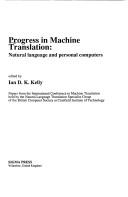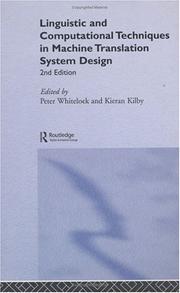Book
Year: 2022 Publisher: Berlin : Language Science Press,
Abstract | Keywords | Export | Availability | Bookmark
 Loading...
Loading...Choose an application
- Reference Manager
- EndNote
- RefWorks (Direct export to RefWorks)
Examining the general impact of the Controlled Languages rules in the context of Machine Translation has been an area of research for many years. The present study focuses on the following question: How do the Controlled Language (CL) rules impact the Machine Translation (MT) output individually? Analyzing a German corpus-based test suite of technical texts that have been translated into English by different MT systems, the study endeavors to answer this question at different levels: the general impact of CL rules (rule- and system-independent), their impact at rule level (system-independent), their impact at system level (rule-independent), and at rule and system level. The results of five MT systems (a rule-based system, a statistical system, two differently constructed hybrid systems, and a neural system) are analyzed and contrasted. For this, a mixed-methods triangulation approach that includes error annotation, human evaluation, and automatic evaluation was applied. The data were analyzed both qualitatively and quantitatively based on the following parameters: number and type of MT errors, style and content quality, and scores from two automatic evaluation metrics. In line with many studies, the results show a general positive impact of the applied CL rules on the MT output. However, at rule level, only four rules proved to have positive effects on all parameters; three rules had negative effects on the parameters; and two rules did not show any significant impact. At rule and system level, the rules affected the MT systems differently, as expected. Some rules that had a positive impact on earlier MT approaches did not show the same impact on the neural MT approach. Furthermore, the neural MT delivered distinctly better results than earlier MT approaches, namely the highest error-free, style and content quality rates both before and after the rules application, which indicates that the neural MT offers a promising solution that no longer requires CL rules for improving the MT output, what in turn allows for a more natural style.
Book
Year: 2011 Publisher: Adelphi, MD : Army Research Laboratory,
Abstract | Keywords | Export | Availability | Bookmark
 Loading...
Loading...Choose an application
- Reference Manager
- EndNote
- RefWorks (Direct export to RefWorks)
Book
Year: 2022 Publisher: Berlin : Language Science Press,
Abstract | Keywords | Export | Availability | Bookmark
 Loading...
Loading...Choose an application
- Reference Manager
- EndNote
- RefWorks (Direct export to RefWorks)
Language learning and translation have always been complementary pillars of multilingualism in the European Union. Both have been affected by the increasing availability of machine translation (MT): language learners now make use of free online MT to help them both understand and produce texts in a second language, but there are fears that uninformed use of the technology could undermine effective language learning. At the same time, MT is promoted as a technology that will change the face of professional translation, but the technical opacity of contemporary approaches, and the legal and ethical issues they raise, can make the participation of human translators in contemporary MT workflows particularly complicated. Against this background, this book attempts to promote teaching and learning about MT among a broad range of readers, including language learners, language teachers, trainee translators, translation teachers, and professional translators. It presents a rationale for learning about MT, and provides both a basic introduction to contemporary machine-learning based MT, and a more advanced discussion of neural MT. It explores the ethical issues that increased use of MT raises, and provides advice on its application in language learning. It also shows how users can make the most of MT through pre-editing, post-editing and customization of the technology.

ISBN: 1850581568 Year: 1989 Publisher: Wilmslow Sigma Press
Abstract | Keywords | Export | Availability | Bookmark
 Loading...
Loading...Choose an application
- Reference Manager
- EndNote
- RefWorks (Direct export to RefWorks)
Book
Year: 2022 Publisher: Berlin : Language Science Press,
Abstract | Keywords | Export | Availability | Bookmark
 Loading...
Loading...Choose an application
- Reference Manager
- EndNote
- RefWorks (Direct export to RefWorks)
Language learning and translation have always been complementary pillars of multilingualism in the European Union. Both have been affected by the increasing availability of machine translation (MT): language learners now make use of free online MT to help them both understand and produce texts in a second language, but there are fears that uninformed use of the technology could undermine effective language learning. At the same time, MT is promoted as a technology that will change the face of professional translation, but the technical opacity of contemporary approaches, and the legal and ethical issues they raise, can make the participation of human translators in contemporary MT workflows particularly complicated. Against this background, this book attempts to promote teaching and learning about MT among a broad range of readers, including language learners, language teachers, trainee translators, translation teachers, and professional translators. It presents a rationale for learning about MT, and provides both a basic introduction to contemporary machine-learning based MT, and a more advanced discussion of neural MT. It explores the ethical issues that increased use of MT raises, and provides advice on its application in language learning. It also shows how users can make the most of MT through pre-editing, post-editing and customization of the technology.
Book
Year: 2022 Publisher: Berlin : Language Science Press,
Abstract | Keywords | Export | Availability | Bookmark
 Loading...
Loading...Choose an application
- Reference Manager
- EndNote
- RefWorks (Direct export to RefWorks)
Examining the general impact of the Controlled Languages rules in the context of Machine Translation has been an area of research for many years. The present study focuses on the following question: How do the Controlled Language (CL) rules impact the Machine Translation (MT) output individually? Analyzing a German corpus-based test suite of technical texts that have been translated into English by different MT systems, the study endeavors to answer this question at different levels: the general impact of CL rules (rule- and system-independent), their impact at rule level (system-independent), their impact at system level (rule-independent), and at rule and system level. The results of five MT systems (a rule-based system, a statistical system, two differently constructed hybrid systems, and a neural system) are analyzed and contrasted. For this, a mixed-methods triangulation approach that includes error annotation, human evaluation, and automatic evaluation was applied. The data were analyzed both qualitatively and quantitatively based on the following parameters: number and type of MT errors, style and content quality, and scores from two automatic evaluation metrics. In line with many studies, the results show a general positive impact of the applied CL rules on the MT output. However, at rule level, only four rules proved to have positive effects on all parameters; three rules had negative effects on the parameters; and two rules did not show any significant impact. At rule and system level, the rules affected the MT systems differently, as expected. Some rules that had a positive impact on earlier MT approaches did not show the same impact on the neural MT approach. Furthermore, the neural MT delivered distinctly better results than earlier MT approaches, namely the highest error-free, style and content quality rates both before and after the rules application, which indicates that the neural MT offers a promising solution that no longer requires CL rules for improving the MT output, what in turn allows for a more natural style.
Book
Year: 1961 Publisher: Englewood Cliffs (N.J.) : Prentice-Hall,
Abstract | Keywords | Export | Availability | Bookmark
 Loading...
Loading...Choose an application
- Reference Manager
- EndNote
- RefWorks (Direct export to RefWorks)
Book
ISBN: 3923435061 9783923435067 Year: 1983 Volume: 7 Publisher: Saarbrücken : Universität des Saarlandes, Sonderforschungsbereich 100 "Elektronische Sprachforschung",
Abstract | Keywords | Export | Availability | Bookmark
 Loading...
Loading...Choose an application
- Reference Manager
- EndNote
- RefWorks (Direct export to RefWorks)
Machine translating --- Traduction automatique --- Machine translating.
Book
ISBN: 981197960X 9811979596 Year: 2022 Publisher: Singapore : Springer,
Abstract | Keywords | Export | Availability | Bookmark
 Loading...
Loading...Choose an application
- Reference Manager
- EndNote
- RefWorks (Direct export to RefWorks)
Chinese language --- Machine translating --- Machine translating.

ISBN: 1857282167 9781857282160 Year: 1995 Publisher: London : UCL Press (University College London),
Abstract | Keywords | Export | Availability | Bookmark
 Loading...
Loading...Choose an application
- Reference Manager
- EndNote
- RefWorks (Direct export to RefWorks)

 Search
Search Feedback
Feedback About UniCat
About UniCat  Help
Help News
News